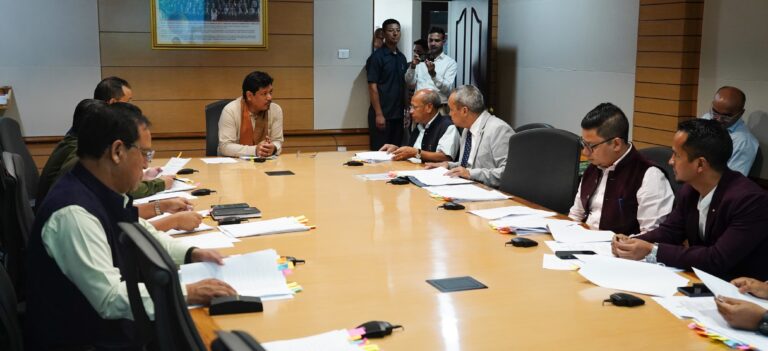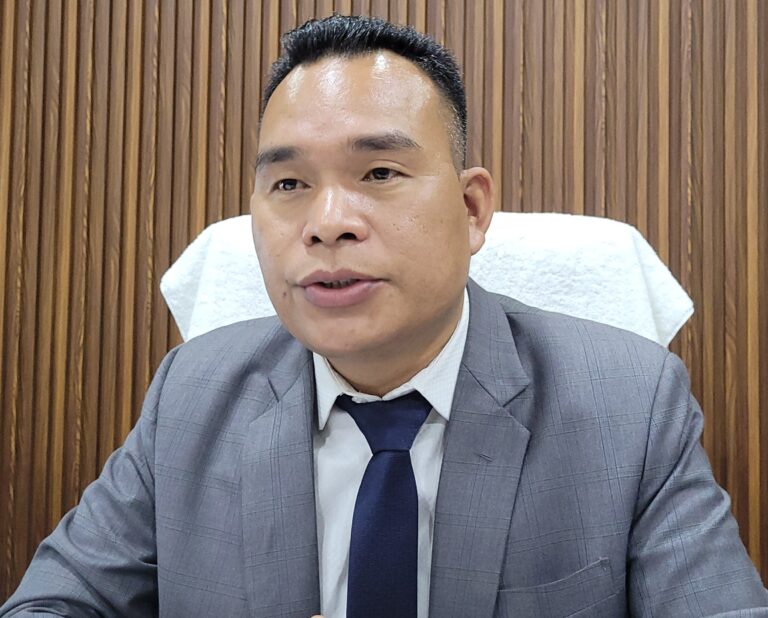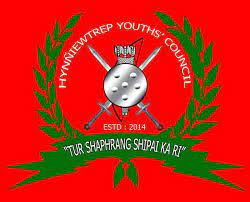THE MEGHALAYA REGULATION OF LANDLORDS AND VERIFICATION OF TENANTS BILL, 2013
INTRODUCTION
Perceived benefits if Inner Line Permit (ILP) is introduced:-
Protection against influx.
Prevention of land alienation.
Greater employment opportunities.
Opportunities in trade and business.
Measures taken by the Government to meet the perceived benefits:-
Sixth Schedule of Constitution:
Special administrative dispensation;
Powers to District Council to legislate on land management, appointment or succession of Chiefs or Headmen, inheritance of property, marriage and divorce, social customs, administration of justice, money lending and trading by non-tribals.
To prevent land alienation, the Meghalaya Land Transfer (Regulation) Act 1971 enacted.
To safeguard the educational and employment opportunities, reservation in the ratio of 40% for Khasi & Jaintia, 40% for Garos, 5% for other Tribals of the State.
Autonomous District Councils have enacted the Trading by Non-Tribal Regulation.
The Meghalaya (Benami Transactions Prohibition) Act, 1980 enacted to prohibit Benami transactions between a tribal and non-tribal.
55 seats in Legislative Assembly reserved for Tribals.
The Inter-State Migrant Workmen (Regulation of Employment and Conditions of Service) Act, 1979 being implemented.
WHY INNER LINE PERMIT (ILP) CANNOT BE IMPLEMENTED:-
The Regulation of 1873 applicable to the Districts of Kamrup, Darrang, Nowgong, Sibsagar, Lakhimpur, Garo Hills, Khasi and Jaintia Hills, Naga Hills, Cachar, Sadiya Frontier Track and Lushai Hils District in its original form.
Subsequently, Regulation repealed in its application to the Garo Hills by the Repealing Act of 1897 (V of 1897).
For extension to whole State, a new law has to be made by the Union Government as the subject matter falls under the Union List.
Shillong a cosmopolitan hub with a sizeable chunk of non-tribal population as permanent residents of the State – anxiety about unnecessary harassment.
Corridor for transit to the Barak valley and to Mizoram and Tripura – legal and administrative implications; crucial difference with Mizoram, Arunachal Pradesh and Nagaland.
Strict enforcement would entail checking of all including indigenous residents – implications thereof.
Adverse perception about the State:
Impact on tourism.
Inflow of investment.
Impact on economy.
Lack of opportunities.
Reverse migration.
Reaction from other States.
Administrative costs – infrastructure and manpower.
Experience of other ILP implementing States – not encouraging.
State cannot legislate – experience of “The Meghalaya Residential Permit Bill, 1973”.
The Bill sought to provide that no person who is not a permanent resident or a Scheduled Tribe resident in Meghalaya shall reside in a notified area for a period of more than 4 months wihtout prior permission of the competent authority.
Permission to be denied if their presence considered injurious to peace and good administration of area; or against economic interests of STs.
The Bill sent to President of India – returned with “I withhold my assent from the Bill.”
Explanation – “I am directed to say that Meghalaya Residential Permit Bill, 1973 is relatable to the “Inter-state Migration” covered by entry 81 of List 1 of Seventh Schedule to the Constitution as the State Legislature is not competent to legislate on the subject.”
The Meghalaya Regulation of Landlords and Verification of Tenants Bill – Salient Features:
A
Bill
to provide a framework for regulation of landlords and compulsory verification of the tenants so as to enhance the security of the citizens of the State and to prevent breach of peace and maintenance of public order.
Definitions.
Section 2 provides :-
(f)“house or rental unit” means any building, apartment, permanent or temporary settlement or colony of industrial workers or miners or labourers or construction workers and such like, hut or shed, or any part thereof, let or to be let or used for residential or non-residential purposes;
(g)“landlord” means a person or a company who owns a house or rental unit or a permanent or temporary settlement or colony for housing industrial workers or miners or labourers or construction workers and such like and shall include his successor-in-interest or assign;
(h)“Local Authority” means traditional bodies or any such bodies constituted in accordance with the tradition and customary practises in respect to areas covered under the Sixth Schedule of the Constitution of India or other authorities in respect to areas falling outside the Sixth Schedule of the Constitution of India, which shall be notified by the Government or by the Deputy Commissioner of the District concerned in the Official Gazette;
(j)“relative or members of family” means blood related family and includes husband, wife, father, mother, mother’s brother, son, daughter including step-son-daughter and adopted son, adopted daughter , and son or daughter of the mother’s brother or sister, father’s sister or brother;
(l)“tenant” means any person who uses or occupies a house or rental unit on paid agreement or otherwise and includes relatives or members of family, successor to a tenant or a sub-tenant or joint tenant.
District Task Force, powers and functions.
Section 4 provides:-
(1) Constitution of District Task Force in each district:
(2) The District Task Force shall consist of :-
(a) Deputy Commissioner as the Chairperson;
(b) Three members from amongst the officials of the district, one of whom from the police department not below the rank of Additional Superintendent of Police and one from the district Labour office;
(c) Two non official members, one of whom a representative from the traditional bodies;
(3) Tenure of non-official member of two years and eligible for re-nomination for a second term.
District Task Force, Police Stations and Local Authority to maintain database.
Section 5 provides :-
(1) The Police Station and Local Authority shall maintain database for strict enforcement of the provision of this Act and it shall be binding on them to submit a quarterly report to the District Task Force:
Provided that in the event of failure to comply with sub-section (1) on account of non submission of database by the Local Authority, the Police Station shall report it to the District Task Force for direction.
(2) The District Task Force shall maintain database and submit to the Government quarterly report and such other proposal pertaining to the functioning of the District Task Force, Police Station and the Local Authority for the implementation of the Act.
(3) The District Task Force and Police Station shall maintain the list of Local Authorities.
(4) If any violation of the provisions of the Act comes to its notice, the local authority shall report it to the District Task Force.
(5) On receipt of a report under sub-section (4) of this section, the District Task Force shall cause a verification and based on its findings, take such further action as deemed appropriate under the provisions of this Act.
Financial and administrative support to the District Task Force, Police Stations and Local Authority.
Section 6 provides :- The Government shall provide financial and administrative support to the District Task Force, Police Station and financial support to the Local Authority for smooth discharge of their functions in implementation of the Act.
Landlord to obtain onetime clearance for letting his house or rental unit from the Local Authority.
Section 7 provides :- Any landlord who intends to let his house or rental unit to be used for tenancy shall obtain a onetime clearance from the local authority.
Landlord and tenant legally bound to furnish documents to the Police Station and Local Authority.
- Section 8 provides :- (1) Every landlord and tenant shall legally be bound to furnish within thirty days of letting out or occupying the house or rental unit, the following documents to the Police Station and Local Authority under whose jurisdiction the area falls:
a) a residential certificate supported by affidavit in Form-A, where the tenant previously resided;
b) a copy of election photo identity card or driving license or ration card or passport or permanent account number card;
c) two copies of recent passport size photograph of each individual family member of the tenant residing with him;
(d) copy of registration in case of labour and trading licence in case of trade:
Provided that persons employed in Government, Government Undertakings shall furnish employment certificate, transfer order or appointment order or office identity card, as the case may be:
Provided further if a student, a certificate from the concerned educational institution or identity card of the school or college or university or educational institution where studying.
(2) Details of information in respect of a tenant and the acknowledgement thereof shall be given as per Form–B of this Act.
(3) Every landlord shall maintain the database of all his tenants.
Duties of Landlord before letting out house or rental unit.
Section 9 provides :- The landlord shall fulfil the following conditions before letting out his house or rental unit, namely,-
(a) house or rental unit has been provided with the minimum basic essential services;
(b) house or rental unit is not overcrowded, norms for which may be as prescribed, and
(c) due care is taken to see that the house or rental unit does not pose any health hazard.
Powers of police and local authority to verify.
Section 10 provides :- Notwithstanding anything contained in Section 8, a police officer of the rank of Officer-in-Charge of the Police Station having jurisdiction and the local authority shall have the power to jointly verify the credentials of any tenant if further so required:
Provided that no police officer and local authority shall undertake the verification under this section except with the prior approval of the Chairman of the District Task Force.
Verification of existing tenants.
Section 11 provides :- In case of existing tenants on the date of commencement of this Act, the landlord and his tenants shall comply with all the provisions of this Act within ninety days of the commencement of the Act.
Withdrawal of essential services in case of non- compliance.
Section 12 provides :- Notwithstanding anything contained in section 13 and such other laws in force in the State, the landlord shall be liable to withdrawal of essential services on the order of the District Task Force if he fails to furnish the particulars of the tenant or sub-tenant or joint tenant to the Police Station as required under this Act:
Provided that no such essential services shall be withdrawn without the landlord being heard:
Provided further that the essential services so withdrawn shall be restored to the landlord forthwith as soon as he furnishes the requisite particulars of the tenant to the Police Station and Local Authority, at the cost of the landlord.
Punishment.
Section 13 provides :- Any landlord or tenant or both who intentionally fail to furnish the information as required under this Act or furnish false information under the Act shall be punished under Section 176 and 177 of Indian Penal Code, 1860 or any other law in force:
Provided that any foreigner, who is a tenant, and does not comply or furnishes false information, shall be punishable under section 14 of the Foreigners Act, 1946 as well.
Chairperson, member and staff of the District Task Force and Local Authority to be public servant.
Section 14 provides :- The Chairperson, members, officers, employees of the District Task Forces and members of the Local Authority as notified shall be deemed to be public servants within the meaning of section 21 of the Indian Penal Code and Section 2(c) of the Prevention of Corruption Act, 1988.
Protection of acts done in good faith.
Section 15 provides :- No suit, prosecution or other legal proceedings shall lie against any member of the District Task Force or any officer of the District Task Force or the member of Local Authority for anything which is in good faith done or intended to be done under this Act or the rules made thereunder.
Power of State Government to amend Forms.
Section 16 provides :- If the Government is of the opinion that it is expedient in the interest of general public so to do, it may, by notification in the Official Gazette, add to, or omit from, or otherwise amend, the Forms and thereupon the Forms shall be deemed to have been amended accordingly.
Power to make rules.
Section 18 provides :- (1) The State Government may, by notification in the Official Gazette, make rules for carrying out the provisions of this Act.
(2) Every rules made under this section shall, as soon as after it is made, be laid before the Meghalaya Legislative Assembly.
FORM “A”
[See section 8 (1) (a)]
Affidavit
[To be typed in a Non-Judicial Stamp Paper]
I………………………….(Name of deponent), S/o / D/o,………………., age about……years, by profession ………………… and permanent resident of………………………… do hereby solemnly affirm and declare as follows:-
1. That I am a bonafide resident of India and presently reside at……………………….
2. That I was a previous resident of …………… village/ town/ city ………. within the jurisdiction of the ……………. Police Station, ……………. District, …………. State, from……to….. (period).
3. That this affidavit is sworn for declaring my earlier residence for the purpose of Section 8 (1) (a) of the Meghalaya Tenant Verification Act, 2013 and submitting the same before the concerned authority.
4. That the statements in this affidavit made in paragraphs 1, 2 and 3 above are true and correct to the best of my knowledge, belief and information and nothing material has been concealed therein.
Signature, Address and
Designation of Deponent
Solemnly affirmed and declared on oath before me by the deponent above named on being identified by …………………………., Advocate on this……………………..day of ……… at………(name of place).
Identified by:
Advocate Magistrate First Class
Form-B
[See Section 8(2)]
Details of information of landlord and tenant for tenancy verification by Police and Local Authority.
Particulars of Landlord
1. Name of the Landlord: _________________________________________
2. Occupation: __________________________________________________
3. Details of permanent address: ____________________________________
4. Telephone/ mobile number: ______________________________________
5. Present address: _______________________________________________
6. Details of domestic help or other workers staying along with the landlord:
Name Age Permanent Residential Address Signature/Thumb Impression
_____________________________________________________________________
_____________________________________________________________________
(*NB: Separate sheet be used to affix photograph of domestic help or other workers along with name and signature or thumb impression below the photograph)
Particulars of Tenant
1. Name: ________________________________________
2. Father’s name/ mother’s name/spouse’s name:___________
3. (a) Nationality: ______________ (b) Age : _____________
4. Address and Phone and mobile number: ____________________
5. Occupation:
(a) If student, certificate and identity card from the educational institution: ____________
(b) If Government servant, employment certificate,
transfer order or appointment order or office identity card: ________________
(c) For doctors / lawyers/ engineers/ architects/ professional drivers/ self employed and other professionals – registration certificate/ number:________________
(d) For migrant workers or those engaged in business/ trade : trading license from respective
District Council or labour registration certificate/ license under relevant law: __________
(e) For others – Permanent Account Number (PAN) card/ electricity bill/ ration
card: ___________________
6. Details of family member residing with the tenant and includes sub-tenants and joint tenants:
Name Age Relationship Occupation Signature/Thumb Impression
___________________________________________________________________
___________________________________________________________________________
___________________________________________________________________
___________________________________________________________________
___________________________________________________________________
___________________________________________________________________
7. Details of domestic help or other workers staying along with the tenant:
Name Age Permanent Residential Address Signature/Thumb Impression
___________________________________________________________________
___________________________________________________________________
(*NB: Separate sheet be used to affix photograph of family members and domestic help along with name and signature or thumb impression below the photograph)
8. Present Address:
& Telephone and Mobile Number
9. Previous address:
& Telephone and Mobile Number
10. Date of leaving the previous address:
11. Permanent address:
& Telephone and Mobile Number
(to be supported by documentary proof)
*Strike out whichever not necessary
Signature of Tenant with Date Signature of Landlord with Date
A c k n o w l e d g e m e n t
Received from Shri/ Smti. _________________________ S/o / D/o ______________________ R/o ________________________________ Phone / Mobile Number _____________________ intimation of letting out of ____________________________ to Shri/ Smti. _________________ ________________________ .
Date __________ Diary No. ______________
Signature of recipient ____________________
Name & Designation ____________________
Police Station ___________________ Office Seal




















Says who???? There is already a Meghalaya Civil Task Force Act 1974, and the Govt should implement that and not try to create reforms to be able to garner loans from World Bank and ADB , as this attributes to the inflation and our future generation will have to repay that loan swindled by the Corrupt.
the arguments for and against, as laid above, does not hold ice…you have formulated your arguments based on flimsy premise relying mostly on presupposed hypothesis and apparent hearsay data. I think the fault lines pertaining to a demand for ILP by a minuscule 9 lakh khasi population spread over only some six district is far more fundamental in nature than is assumed to be…demanding a little bit more of serious theoretical engagement that is currently missing….you argued that the ILP would have Adverse impact on tourism, investment, economy, opportunities, Reverse migration, Administrative costs – infrastructure and manpower and that the Experience of other ILP implementing States – not encouraging, ….is at best flimsy….at this hour when there are arguments and counter arguments being posit…could you at least provide more concrete factual data pertaining to education, health, employment, critical infrastructure, and
investments….i would love to participate in the debate especially in the light of the changing geopolitical strategies vis. Look East Policy and the internationalization of indigenous peoples struggles against the onslaught of dominant communities on politico historical spaces of tribal peoples…
The Meghalaya Regulation of Landlords and Verification of Tenants Bill 2013 says nothing about containing influx in our state of Meghalaya where almost the indigenous people of the state have almost become minority in their own Home-Land.
Therefore, ILP as implemented in the other neighbouring state of Mizoram, Nagaland and Arunachal Pradesh is the only solution to the presence dangerous scenario that occurs against our minority indigenous people.
The District Task Force of the Government mentioned in “The Meghalaya Regulation of Landlords and Verification of Tenants Bill -2013” will just end up in smoke like many other District Task Forces constituted in the districts of Meghalaya.
This clearly indicates that the current govt is not serious to tackle influx. Which section of this bill ever mention the word Illegal immigrants? And the word tenants may refer to both indigenous and non indigenous people of meghalaya. This bill will only open Pandora’s Box.
In ta Bill, More powers to ta local bodies is needed. However, wen it comes to safety, life n death course of action it should be dealt jointly by ta local bodies n ta Govt body.
Awareness n training needed for local bodies n dey shd be made accountable for their own areas of jurisdiction.
The whole bill needs to have a thorough check up before bringing to the assembly for a debate or discussion because i do not see from any angle that it is going to benefit or protect the indigenous tribe (Khasi). Instead the whole bill is full of flaws and if introduce will encourage more influx into the state.
The bill shows nothing positive interest or profit to the Meghalaya citizen. It is a very burden to the Khasi, Jaintia and Garo people. It destroy the rights of the people. Ignorant to the Local Authority. It is a trap to the Magalaya tribes and found nothing protection/safety to the Tribes. It is a wide door to the influx/outsider. Therefore, the Govt. change/revise otherwise better to quit it.
Deputy Commissioners, Police Officers, Advocates know nothing more than the Local Authority/Dorbar Shnong about their own resident/People/citizen. Local Authority/Dorbar Shnong only are the rightful to certify their own people not by the Government Task Force. This bill found nothing good/safety but dangerous to the Meghalaya People.
You need to change and posted another editor choice.